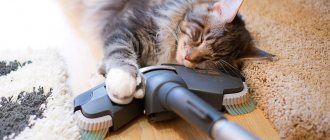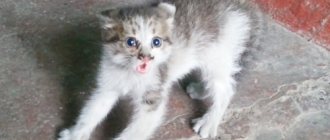Why do cats climb into boxes?
It is difficult to understand a cat's psyche, moods and desires. It is difficult to study them, as well as to understand the results of experiments conducted on them. However, research has revealed the following - murks strive for secluded places, looking for comfort and safety.
Research is good, but as know-it-all cat owners, we are no less curious and also want to know why cats like to sit in boxes and bags, considering all the possible options. Let's start with the simplest versions.
Ambush game
When a cat hides, we perceive it as just another prank. The little predator doesn’t think so; he is now catching his prey. You can’t escape instinctual needs, and our cat’s distant ancestors got their food from ambush. Why is the box not a shelter for a surprise attack? So the pet lurks, preparing to pounce. If you want to check, walk past the shelter and with a high degree of probability a lightning attack will be made on your leg.
Ear for music
I think many people have noticed that cats love rustling objects. You know why cats and cats like boxes - right, because of their wonderful rustling sound.
You can often notice that a pet, having taken a fancy to a bag or cardboard shelter, begins to dig and bite corners there. By the way, cats love to chew on boxes for the same reason. And if you do this inside, the sound is also amplified due to the echo.
Hide and seek from society
The cat is not a strategist in the field of resolving conflict situations. It is easier for her to avoid meeting a possible enemy. That's why cats climb into boxes not to solve problems, but to hide from them. But even in a great mood, Murka also does not shy away from cardboard fun.
Personal space
If you are wondering why cats love boxes, then it will not hurt to know that for a pet, having personal space is just as important a factor as for a person. Having taken a fancy to a cardboard shelter or even a package, the pussy “settles in” in its place, a personal room, saturated only with its aromas. So, if you notice that your pet’s interest in the box is more than idle, arrange a home for him. A warm pillow along with a favorite toy will take your cat to the skies.
The smell of cardboard is a habit
Cats are often housed in boxes after lambing. In this case, the smell of cardboard is one of the first, and therefore familiar, aromas that the kitten remembers. In addition, the smell of childhood reminds a purring mother. In addition, the boxes are made of paper, which, in turn, is made of wood - a natural material that reminds your pet of wild roots. This is especially true for cats that are never outside.
Feeling of security
It may sound ridiculous, but cats' love of solitude and boxes is often based on this factor. Conduct an experiment, place several boxes of different sizes in front of your pet, and he will definitely climb into the one that is ideal for him in size. But even if there is nothing suitable for the dimensions of the mustache, he will make every effort to fit there at least partially.
It is believed that cats completely relax in boxes. Instincts tell the pet that a dense environment is protection, similar to natural shelters, such as a hollow in a tree.
Why do cats like to sit in boxes and people like to look at it? But this is a whole lot of fun not only for the fluffy one, but for all family members. The performance can be made even more colorful if you use your imagination. Cut several different holes in the box or build a cat house out of cardboard and see how enthusiastically your pet will begin to master the new structure.
What do you like about boxes?
In the eyes of a cat, a cardboard box can become a refuge or an object for play. Often cat owners use this packaging to create large play complexes. However, the cat does not necessarily need the box to be lined with warm material. If she likes it, it will be her favorite subject, taking up a lot of her free time.
The smell of childhood
Some believe that the reason for the interest may lie in the relationship between cardboard and wood. It is likely that the cat smells the native smell of wild nature. However, a more plausible version is her childhood memory: as a kitten, she was with her mother in a cozy box. And therefore he can remember the smell.
If an animal climbs into a box and, purring, fiddles with its bedding for a long time, moving its paws, then it is so. This instinct has been ingrained in cats since childhood. This behavior is typical of small kittens who fall asleep near a cat. This reassurance, a feeling of protection and absolute peace, is what a cat is looking for all its life. Some cats behave in much the same way in their bed before bed.
Social factor
In addition, the box can become a kind of cocoon that protects the cat from stress. This fact is evidenced by studies of scientists working with domestic cats in shelters. A cat without shelter feels unprotected, it is susceptible to stress and has poor contact with people.
The behavioral strategy of hiding helps an animal to hide from something it may be afraid of.
If the pet does not have its own place, it is likely that the box will perform exactly this function. Some cats occasionally use boxes as a social barrier. Hiding in it, they feel protected from the owner’s reprimands, screaming or noise. These situations are rare; only in the absence of another secluded place will the cat hide in the box.
Toy box
The gaze of an active cat rarely misses small boxes or mailboxes. Small objects become anti-stress toys, large ones become shelters in which you can hide while tracking down prey. Funny pets think they can't be seen in boxes. They get tremendous release from playing, scratching, biting or throwing objects from place to place.
Cats often spend a lot of energy chewing on boxes. Such activity is necessary to waste excess energy, after which the pets tune in to a sweet dream.
Some individuals manage to stick their snouts into narrow boxes, and this does not bother them at all. In their games they rarely set any boundaries for themselves.
Cardboard is used to make scratching posts. It does not injure the animal when it wants to scratch its claws, and allows it to “break away” in a fit of active games. Some individuals play to the point of gnawing holes in the boxes, biting the paper with pleasure. They are sensitive to rustling sounds and enjoy creating them themselves by scratching and biting cardboard boxes.
Cat hiding places in nature
For a person, a box is a capacious container and nothing more. For a cat, a box is a real refuge.
The box is a shelter for cats
All modern cats, both purebred and stray, have a wild forest cat in their ancestors. This is a fairly large fluffy animal, a dexterous hunter that attacks not only birds and rodents, but even roe deer, competing with lynx.
The wild forest cat is found in European and Caucasian deciduous forests. A wild cat has excellent hearing and vision, but its sense of smell is a little weaker, and it is impossible to be on guard 24 hours a day. Of course, she does not build houses for herself and does not dig holes, but she willingly takes refuge from bad weather and enemies under fallen trees, in hollows, abandoned fox and badger holes. Even a dense interweaving of branches, a rocky depression, a densely overgrown island in a floodplain, or a small hole will do. A wild cat is unlikely to sleep on an open lawn - it will climb higher on a tree or hide.
Cats feel calmer in a box
A wild cat waits out bad weather in its den; it may not go out hunting for up to three days. Female wild forest cats arrange a secluded place, preparing it for future kittens: they drag dry leaves, bird feathers and grass there. In such a cozy den, the kittens will be safe and the cat will be calm.
Why do cats and cats like bags?
You may quite rightly ask why cats like bags. After all, if everything is already clear with the box, then what attracts the pet to the rustling device for transporting things. The answer to this question is as simple as in the situation with boxes:
- a game
- curiosity
- opportunity to hide
In addition, we often bring food home in bags, and all cats certainly like it. Animals are attracted to the smell of food or the street. So they run around with the bag, enjoying the pleasant aromas.
As you can see, cats’ love for boxes and bags is due to various reasons. Don’t think about them, just let the purr enjoy life and rejoice with it.
Fun and a way to deal with stress
Cats love boxes and shopping bags for clothes, shoes or food, because for them these are unknown objects with which they can frolic.
What makes bags and boxes especially attractive is that they can:
- fly and jump;
- turn over on different sides;
- it's very funny to make noise;
- You can also chew them, scatter them into pieces, and hide inside.
Therefore, one of the first reasons why all cats adore cardboard boxes so much is very banal - they can frolic with them and relieve stress.
Yes, yes, a cat can also get a release from “showdowns” with a box, like we do from hitting a pillow. Therefore, an angry cat can smash the new box into small pieces, and then calmly go to his favorite corner and enjoy the victory.
Why do they chew packages?
Plastic packaging attracts pets no less than cardboard packaging. There are times when a pet furiously tears a plastic bag with its teeth. This does not mean that he lacks any substances or is sick. Not at all: if you are sick, have a vitamin deficiency or feel unwell, the cat is not interested in the bag. The animal entertains itself this way, because, you see, the owner often pays too little attention to it.
The cat begins its play by rustling and often by tossing a package. While entertaining herself, she may give in to her predatory instincts, similar to those when she plays with a mouse. Other individuals like the way their claws dig into the polyethylene. If the cat seriously chews or even eats the bag, most likely there was something edible in it, which left an attractive smell for it. For the same reason, the cat licks bags.
What to do?
Eating newspapers is dangerous for an animal's life.
A single use of ordinary paper sheets rarely causes harm to your pet's health, but a large lump can lead to intestinal obstruction. In this case, the cat may need surgery. Newspapers with printing ink are very dangerous, since the consequences of their use are serious intoxication of the body with ink and upset of the gastrointestinal tract. It is necessary to remove all sheets from the cat, and if the pet shows interest in it, hide the toilet paper in a recessed, closed holder. To ensure that giving up a dangerous habit goes smoothly, it is recommended to offer your pet an alternative, such as fresh grass. But you can’t take it on the street, as it can cause poisoning and gastrointestinal upset. You should grow weed on a windowsill. If the cat’s behavior is dominated by the desire to play with paper pieces, then she needs to buy balls, artificial mice, or make toys herself. But when a pet is purposefully looking for sheets, pieces of a box, newspaper to eat, you need to examine its oral cavity. The specific smell of pus, bleeding gums and rotten teeth signal the need to visit a veterinarian. If problems are confirmed, it is recommended to carry out ultrasonic cleaning of the enamel and temporarily abandon wet food, which creates an environment in the mouth suitable for the proliferation of pathogenic microorganisms. It is better to give preference to dry food. If the animal is on a natural diet, then its diet should be enriched with cereals, vegetables, and fermented milk products of medium fat content.
Finding a safe place
The way of life requires animals to find a safe shelter. Wild cats sleep most of the day. This is how predators save the energy needed for hunting. While resting, they need a safe place, protected from other animals. In nature, they climb trees, find holes, and hide in bushes.
At home, pets do not require such tricks. But instinct pushes us to search for shelter, explaining why cats love boxes and bags.
Even a small object seems like a suitable place for them to hide. A cat can settle into a box that only fits its paws and feel comfortable. The pet is calmed by the presence of limited space. Scientists have shown that access to boxes reduces stress in pets.
Shelter provides a feeling of security - the cat understands that it will not be attacked from behind or from the side. All potential threats must be brought into view.
An enclosed space becomes a cozy couch. But only if the cat got there voluntarily. Forcible attempts to place your pet in a carrier or bag will be met with aggression. But the cat can explore the same container on its own and choose it for sleeping or resting.
It is worth giving mousecatchers a choice of several hiding places. When bringing a cat home for the first time, it is advisable to release:
space under the bedside table (table);
a place in a closet with an easy-to-open door.
The animal will choose the offered shelter or find its own. So, the cat will hide in a constantly forming pile of clothes for ironing, a box under a folding chair (sofa). The presence of stationary shelters will not affect the interest in abandoned boxes (packages).
The curiosity that boxes and bags evoke
The packaging brings an abundance of smells. This is one of the reasons why cats lick bags. They also leave traces of the contents. Animals are attracted to the smell:
So, a cat will climb into a box of bleach, a product containing chlorine. Pets are attracted to new scents, especially those containing traces of other animals. The cat will show increased interest in a country box, a bag that has been in contact with the local fauna.
For pets, packaging becomes a source of information about the outside world. The contents, places of injury and production leave aromatic traces that can interest the pet. Having climbed into the box, the cat receives information about other places without leaving the room (yard).
Hunting or game
Entertainment is an additional reason why cats lick bags. In addition to food debris, the material attracts them by rustling and pliability on the claws. A cellophane bag becomes a favorite toy until it becomes unusable. Attracted by a scent or hiding space, the cat climbs into the bag.
The rustling light material is an interesting prey. The cellophane moves with a slight blow or push, prompting the animal to enter into a “fight.” Cats also see other packaging as a potential toy. How they are attracted to a surface for sharpening their claws:
- polystyrene foam, other foamed plastic;
soft woods.
The materials are used to produce containers where cats can hide: completely or “nominally”, climbing into a box without a lid or a box with large holes. From a hiding place, the pet can hunt others. Structures made of soft materials allow for additional improvement of the shelter. The pet tears off pieces of the structure, creating additional toys; makes holes, creates grooves, sharpening claws.
Reasons why cats are partial to cardboard boxes or bags
Every owner of a mustachioed purr knows that if you leave a shopping bag on the floor, your pet will immediately be found in it. There are many versions of why animals revere enclosed spaces in the form of bags or boxes, and they are all quite logical and justified:
- Smell . The cat knows absolutely all the smells in the house, so the appearance of a new object arouses genuine interest in it and the need to immediately thoroughly examine it. And if something aromatic and tasty was brought in this package, the cat’s interest is quite understandable.
- The spirit of competition . A bag is an amazing item for a cat. It moves under the influence of air or if you touch it, and even makes rustling, attractive sounds. Add to this electrical static, due to which the bag sticks to the fur - what is not an insidious opponent attacking the cat? For many cats, bagging is a fun, active game where the winner must end up inside a foreign object.
- Static – when a cat gets into the bag, static electricity affects its fur, causing a very pleasant sensation in the animal.
- Anti-stress relief . Psychologists advise people to relieve emotional stress by beating a pillow, putting all their negative emotions into the force of the blows. For cats, the bag is similar to a whipping pillow. “Fighting” with the package, the kitty gets very angry, all the negative emotions come out of it, therefore, climbing inside the “defeated enemy”, the cat calms down and relaxes.
- Shelter . The cat, although a predator by nature, is small. Its genetic memory reveals memories of being hunted by large predators, so it is a natural instinct to seek cover, and a box or bag is an excellent place to hide.
- Memories . There is an opinion that cats love to sit in cramped boxes and bags because they experience the same sensations in them when they were kittens, and their mother warmed them with her fur. Another reason is the smell of cardboard. When a cat has lambed, she and her kittens are usually given a place in a box, the smell of which is the first thing that newborn babies remember for the rest of their lives.
- Comfortable temperature . The simplest explanation is why pussies love to sit in bags and boxes - it’s warmer there. Purrs love warmth, and accordingly, in such shelters they feel most cozy and comfortable.
- Mustache and rest . A cat's whiskers are not just an antenna for perceiving the outside world, but a separate organ that is constantly at work, monitoring the slightest vibrations in the air and odors. When the animal sits in a box, in conditions of limited space, it does not need to be constantly alert, and it simply rests.
- Associations - the bag is used to carry food, and pets often watch how their owner takes out their favorite treat from a rustling object. And if it ends up on the floor, why not examine it to see if there’s something tasty hidden there?
- Wild roots. Before cats were domesticated by humans, they lived in forests, among many pleasant-smelling trees on which they sharpened their claws. Cardboard for boxes is made of wood, and it is its smell that is captured by the animal’s incredibly keen sense of smell. This is another reason why purrs love to be inside cardboard objects.
Surprising but true! An unusual explanation for the phenomenon of cats’ love for boxes and paper bags in 2021 was proposed by Fardin Mark-Antony, a physicist. He said that a cat is a liquid, which means it can be in three states of aggregation - solid, liquid and gas. And since gas and liquid are consistencies that fill any volume, the cat climbs into the box to fill it with itself.
Also watch the video why cats love boxes:
Matter of habit
A special opinion about why cats like boxes is the version that humans artificially instilled this habit in them. The thing is. that domestic cats most often give birth to their offspring in cardboard containers, and therefore, the smell of this material becomes familiar to kittens from birth.
It is from the very first days that animals associate the aroma of cardboard with warmth, comfort and security, and so that your pet loves to sit in your arms with the same intensity, you can try to accustom him to this from childhood.
Dangers that an animal may encounter when playing with bags
After playing, your pet may tear the bag and swallow part of it. Polyethylene is very negatively perceived by the cat's digestive tract, especially if the animal is older than 7 years.
Important! Self-medication and attempts to induce vomiting are unacceptable; it is important to contact a veterinarian as soon as possible.
A piece of cellophane stuck in the throat can cause a cat to suffocate, so postponing a visit to the clinic in the hope that it will go away on its own is unacceptable.
Sacks, boxes, bags - these are the best resting places for cats
Cats and boxes have long been a popular subject for Internet videos and photo collections. Animals really like the opportunity to climb into a cardboard container, curl up inside and watch from the side the amazement that inevitably arises from the owner. A good idea is to lay an old warm jacket on the bottom to keep your pet warm and cozy. The cat will certainly thank the owner for such care by purring.
The fascination of the spectacle and precautions
You cannot scold a pet that climbs into boxes and bags left on the floor by its owners.
For cats living in confined spaces of apartments, this is the most fun and variety in a routine, measured existence. Watching such games is a pleasure, causing sincere laughter and tenderness among the owners.
If a person is away from home for a long time and cannot provide his pet with regular active games, when leaving for work, you can leave a box on the floor, the cat will be actively busy all day. However, precautions should be taken when “communicating” your pet with a bag or box:
- If you leave your pet alone with an interesting item, preference should be given to boxes, since your pet may get confused in the bag.
- The items left behind should not contain polystyrene foam, receipts or other foreign objects that the animal might “test” out of curiosity.
- When leaving your pet alone with the bag, it is recommended to remove sharp and shaky objects from the room. After all, when running with a bag, a cat can get hurt on sharp corners.
- The box must be intact, or the owner himself can make slits in it for the cat to climb into.
- “Toys” should not stand at a height - a closet, a windowsill. A cat that gets into them can play with them, lose its balance and fall to the floor with the box, injuring itself.
- Labyrinth. Inventive owners can connect several boxes together to form a tunnel with slots. The animal will be delighted with such a gift - a whole complex of attractions.
How to build a game complex from boxes
Some loving owners independently build grandiose play complexes for their pets from cardboard boxes alone. The material is cheap, the work is simple, but that’s not all. Such play complexes are environmentally friendly and safe, cats really like them, and are easy to repair and modernize. But to create such a masterpiece of box architecture from cardboard “Lego bricks”, you need to be not only a dreamer, but also a real master - not everyone can do it.
This is what beauty you can build for cats from ordinary boxes
Cut more “windows” in the box and it will become extremely interesting for cats
There are a great many ideas for such cardboard toys and complexes, from very simple options to quite complex ones. But you will probably come up with your own box exercise machine that your cat will especially like.
Photo gallery: box locks and “gyms”
A trainer made from boxes is not only cheap, but also beautiful.
Set up a sports corner where there will be boxes, a scratching post, and other “projectiles”
If you have a lot of space and a lot of cats, create a “box paradise” for them.
Place a small box in a large one - cats will love it
Make “honeycombs” out of boxes - cats, like bees, will “fly” from one to another and hide in them
You can build funny toys from boxes - for example, a car or even a tank
Scientific research
This question has interested even the scientific minds of our world for a very long time, and there are a huge number of versions on this subject. The famous Dutch veterinarian Claudia Vinck has been studying the behavior of cats in shelters for a long time. The decisive experiment in her work was the experiment with newly arrived animals that were still in a state of stress. Wink seated them in two different rooms, one of which was equipped with various hiding places, and the other remained free for prying eyes. As a result, animals with the opportunity to be left alone with themselves adapted to new living conditions much faster.
The result of the study was confirmation of the opinion that it is easier for cats to run away and hide from problems than to solve them, regardless of their size and habitat.
The nature of cats: what makes studying their behavior difficult?
Modern cats, well known to everyone, are very “old” animals. They came to us thousands of years ago from hot desert regions.
This fact suggests that cats are very hardy and intelligent creatures.
2 main reasons why cats are afraid of cucumbers
Today, every second family has a pet, and in more than 35% of cases it is a cat.
But I hasten to note that the trend towards the popularity of cats was not evident at all times.
In ancient times, cats were highly respected and were often even considered sacred animals. But the current demand for felines only increased by 1950. It was at this time, about 50 years ago, that the cat became the most popular pet, and in many countries it remains so to this day.
As cats began to be brought home more and more often as pets, researchers began to actively study the preferences, nature and behavior of cats.
But, as it turned out later, studying cats is not at all easy. The actions of cats sometimes cannot be explained at all, which gives rise to a lot of controversy regarding certain feline actions.
Scientists from all over the world have come to the conclusion that cats are very smart and “independent” animals, so many aspects of their behavior remain a mystery.
Why do they play with cellophane?
Cats are naturally extremely curious and interested in everything. They love the rustling sound; some members of the family like to inspect every package they see in the house. They can climb into them, sit inside for a long time and be sincerely offended when they are scolded for this. Cat nature is such that furry pets look at everything in their own way. Sometimes breeders jokingly note that their pets were born in bags - they are so attracted to them. Moreover, cats sometimes not only play with bags, but even go to sleep in them.
Plastic bags are different from conventional toys. During play, they not only rustle, but also magnetize the wool when they come into contact with it. Cats love everything unusual, giving free rein to their instincts. In addition, they may associate the sound of a rustling package with a call to hunt.
Being in a playful state, the cat can play along with itself by tossing the bag or trying to touch it as often as possible in order to hear an interesting rustling sound again and again.
Why is it so important for a person to know everything?
We are not able to find a reasonable explanation for every pet habit; this is not necessary. There is a certain charm in this - observing the behavior of a pet and funny situations that are completely devoid of logic. We can only guess whether cats are really attached to us or whether they are just pretending to guarantee themselves cozy housing and food.
So what is the reason for our four-legged friends’ addiction to certain types of objects? Seeing an empty plastic bag or cardboard box left by the postman, cats immediately pounce on the item and find a use for it. Here's what pet behavior experts explain about this habit.











